Reflections from Red Badger's 2025 Partner Day
Dive into Red Badger's Latest Annual Partner Day and learn how alignment, strategic hires, and client trust are central to how we're creating shared...
This is the story of how Red Badger defined and designed a solution to tackle social inequality through a product transformation mindset.
This is the second article in a 3-part series documenting how Red Badger built a mission-oriented product company from the ground up.
If you haven't already, make sure you read part one first, where we talk about building a mission-driven business from scratch before exploring our strategy, reasoning and approach.
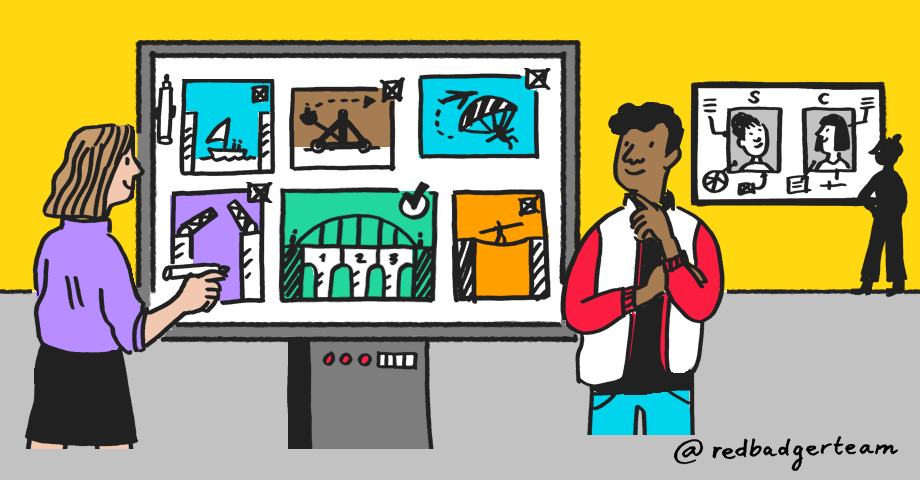
With the problem clearly identified, a potentially global market defined and a cross-functional team assembled, the hard work could begin.
What product or service could bring together the most effective solutions and practices in social mobility?
To answer that, we set about exploring potential problem areas, solutions to tackle them and sharpen the team's focus around the best possible outcome.
This article showcases how Talent Compass (now Open Doors) came to be.
Through rapid prototyping, continually enhancing product ideas and testing for desirability, this is the story of how the team identified potential product business opportunities to improve social mobility for people from underrepresented and marginalised groups of society.
The previous post highlighted how Red Badger’s Product Strategy approach runs through three distinct phases. This is the second phase, Rinse.
The Rinse phase typically consists of several weeks of 5-day sprints following the Design Thinking Methodology.

The aim of these sprints is to identify multiple desirable solutions to address a real customer’s needs or pain points.
Each Rinse phase begins with a kick-off, agreeing on a focus. For this phase, it was “enabling 18-25-year-olds from underrepresented and marginalised backgrounds to enter the workforce," and the target customer personas for each week.
Drawing upon the subject matter expertise of the Mission Beyond trustees, two personas were identified:
Each 5-day sprint starts by listing assumptions about the journey the chosen persona is likely to embark on in order to fulfil their needs within the focus area.
Interviews are then conducted with real people that match the persona to provide context.
This helped the team empathise with customers lived experiences and dispel previous assumptions about their wants, desires and challenges.
Next, the team brainstormed 100 or more ideas for products and services they hypothesised would be of value to the customer, based on what was heard during interviews with them.
“The key to a great brainstorming session is to come up with as many diverse ideas as possible, no matter how crazy or bad they sound,” says Ramsay Albazzaz, UX Designer at Red Badger who helped champion design thinking within the cross-functional team.
“Getting the not-so-good ideas out the way first allowed us to hone in on our customers' most pressing needs and develop viable ideas.”
With a large crop of ideas collated, a ‘rinse’ was run through them and the most compelling ones were brought forward to test for desirability.
To test for desirability, a painted-front door test was launched. This test involves developing a landing page for a product not yet on the market and measuring user sign-up intent as a proxy for desirability.
The agreed measure of success/desirability was a 3% conversion rate.
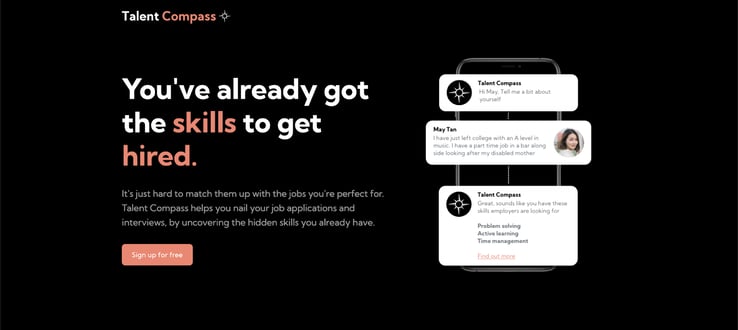
During the second 5-day sprint, an idea was developed for Sophie called “Talent Compass”. The hypothesis tested was:
We believe Sophie would value a product which surfaces her career-relevant skills after analysing a conversation about her talents, passions and achievements, so she can speak about them confidently in the job application process.
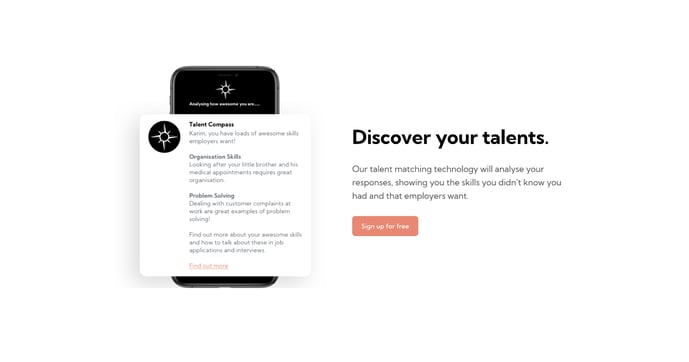 In discussions with the target audience, it was clear Sophie lacks awareness and confidence of the value she brings to an organisation.
In discussions with the target audience, it was clear Sophie lacks awareness and confidence of the value she brings to an organisation.
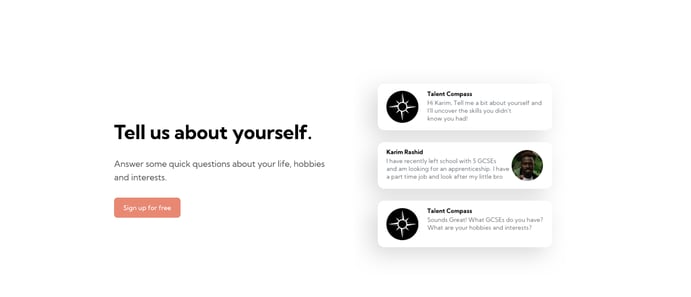
Talent Compass aims to resolve this disconnect through a chat-bot interface. This interface uses open-ended questions to draw out Sophie’s personal values, skills, interests and experiences ready for translation into a relevant job which she would enjoy.
The painted front-door test for this particular idea delivered an extraordinary 8.2% conversion rate. It was clear the proposition was special, delivering high engagement.
Up until this point, the Rinse phase had consisted of multiple sprints aimed at finding the right problem to solve and the most promising way to solve it.
The end goal of the Rinse phase, however, is to build a compelling business case to validate the theoretical business model. It is to explore whether the most promising proposition from those tested is worth pursuing to address the problem and audience outlined in the Ready phase.
To identify which proposition to take into the Rehearse phase, a filtering system was deployed, incorporating the lenses of viability and feasibility.
The filtering system is created in collaboration with the client stakeholders by identifying 3-5 items to rank each proposition against in order to identify a winner.
These scales can include any of the following:
As this Rinse phase was just 3 weeks long, only two value hypotheses (proposition ideas) were tested. Because Talent Compass was the only successful proposition tested, there was no need to create more specific filters.
The final week of the Rinse phase is centred around generating a business model, around the successful proposition, to test in the Rehearse phase.
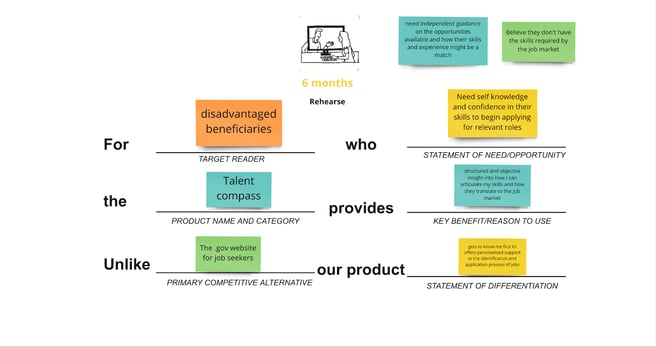
Before creating the business model for Talent Compass, a number of workshops and individual work were conducted to align on the:
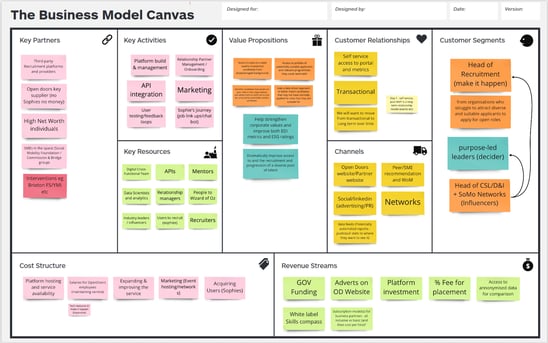
A business model canvas was created, including key activities, resources and partners needed to deliver the value proposition and identify assumptions needing to be tested.

The riskiest assumptions from the business model were prioritised to create a backlog of experiments to conduct during the Rehearse phase.
"This was a critical part of the process, not only did we have to validate Talent Compass as a potential business, we had to clearly show how it would help us tackle our broader mission to positively impact young people’s lives," says Cain Ullah, Red Badger Board Member and Founder and former CEO.
“The painstaking work testing and eradicating assumptions required great discipline, a great framework and great commitment. The Red Badger team left nothing to chance and used real data and information to inform any and all decisions taken, all but guaranteeing the best ideas won through.”
The team felt strongly that a 12-week Rehearse phase would enable the validation of the proposition’s business model or a pivot where appropriate, which would ultimately support the aim of increasing social mobility.
This conclusion was presented to Mission Beyond and the board of trustees, where funding was secured to act on the following recommendations:
To test the first ‘slice’ of Talent Compass, the key recommendation was to treat Sophie as the primary customer, and Employers and Intermediaries (mentoring programmes, career advisors, etc) as partners.
From the work conducted to prioritise the riskiest assumptions, it was proposed the first month be focused on determining whether:
Once month 1 assumptions were validated (or disproven) the next steps were to identify if:
There was evidently a healthy tension between the need to focus on product (for desirability) and platform (for feasibility). The following recommendations were made to balance this tension:
Product Focus
Platform Focus
Through funding the Rehearse phase, a demonstration of trust in Red Badger’s team and Product Strategy proposition to solve their mission, Mission Beyond went from internal sponsors to external client stakeholders.
In the next post, you can find out how the proposition evolved into the Open Doors platform, and how the accompanying product roadmap was delivered to bring it to market.
Dive into Red Badger's Latest Annual Partner Day and learn how alignment, strategic hires, and client trust are central to how we're creating shared...
Clementine Patrick-Brown, Principal Product Designer at Red Badger, dives into the successes of Red Badger's latest Design School Week.
Discover five key lessons from implementing OpenTelemetry in micro services.
Add a Comment: